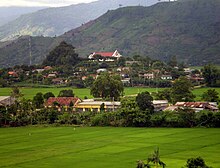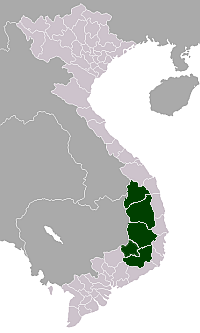Tây Nguyên, translated as Western Highlands and sometimes also called Central Highlands, is one of the regions of Vietnam. It contains the provinces of Đắk Lắk, Đắk Nông, Gia Lai, Kon Tum, Lâm Đồng.
This region is sometimes referred to as Cao nguyên Trung bộ (literally "Midland Highlands"), and was referred to during the Republic of Vietnam as Cao nguyên Trung phần (literally "Central Highlands").
Contents[hide] |
[edit] Provinces
| Provinces | Capital | Population (Census April 1, 2009) | Area (km²) |
|---|---|---|---|
| Dak Lak | Buon Ma Thuot | 1,737,600 | 13,139.2 km² |
| Dak Nong | Gia Nghia | 407,300 | 6,516.9 km² |
| Gia Lai | Pleiku | 1,161,700 | 15,536.9 km² |
| Kon Tum | Kon Tum | 383,100 | 9,690.5 km² |
| Lam Dong | Da Lat | 1,179,200 | 9,776.1 km² |
[edit] Demographics
The Tay Nguyen region is home to a large population of ethnic minorities such as the people of Malayo-Polynesian languages (Jarai and Ede) and the people of Mon-Khmer languages (Bahnar and K'hor). Therefore, the Degar organized the FULRO (1964–1992) and the Montagnard Foundation (1990–), and are continuing the Montagnard Independence Movement from Vietnam.
[edit] Geography

Tây Nguyên is a plateau، bordering the lower part of Laos and northeastern Cambodia. Kon Tum Province shares a border with both Laos and Cambodia but Gia Lai Province and Dak Lak Province only share borders with Cambodia. Lam Dong Province is landlocked, and thus has no international border with any other nation.
Actually, Tay Nguyen is not situated on a unique plateau, instead it lies on series of contiguous plateaus, namely Kon Tum at the height of 500 m, Kon Plông Plateau, Kon Hà Nừng Plateau, Pleiku with the height of around 800m, Mdrak Plateau of approximately 500 m, Đắk Lắk of around 800m, Mơ Nông with the height of about 800–1000 m, Lâm Viên Plateau of approximately 1500 m and Di Linh Plateau of about 900–1000 m. All of these plateau are surrounded by the high mountain ranges and mounts (South Anamite Range).
Tây Nguyên can be divided into 3 subregions according to its deviation in topography and climate, namely: North Tay Nguyen (Bắc Tây Nguyên) (inclusive of Kon Tum and Gia Lai Provinces), Middle Tay Nguyen (Trung Tây Nguyên) (covering provinces of Đắk Lắk and Đắk Nông), South Tay Nguyen (Nam Tây Nguyên) (Lâm Đồng). Trung Tây Nguyên has lower altitude and therefore has a higher temperature from other two subregions.
[edit] Agriculture
Tay Nguyen contains in it many primitive forests and is protected in its national parks, such as Cat Tien National Park, Yok Don National Park, Kon Ka Kinh National Park. The region has an average altitude of 500–600 m with basalt soil, suitable for planting coffee tree, cacao, pepper, and white mulberry. Cashew and rubber plants are also planted here. Coffee is the most important product of Tay Nguyen, with production centred in Dak Lak Province. The provincial capital of Buon Ma Thuot hosts a number of major coffee factories, including ones owned by major producer Trung Nguyen. Tay Nguyen is also the third natural bauxite source in the world[citation needed]. Plans for bauxite mining in the area have met with some controversy, both because of the environmental impact of the proposed operations, and because of labour issues.
[edit] Flora and fauna
Tay nguyen is the home to most prominent and also most endangered species of Vietnam and Southeast Asia: the Indochinese tiger, the huge gaur, the Wild Asian Water Buffalo, the banteng, and the Asian elephant.
(copy of wikipedia)


No comments:
Post a Comment